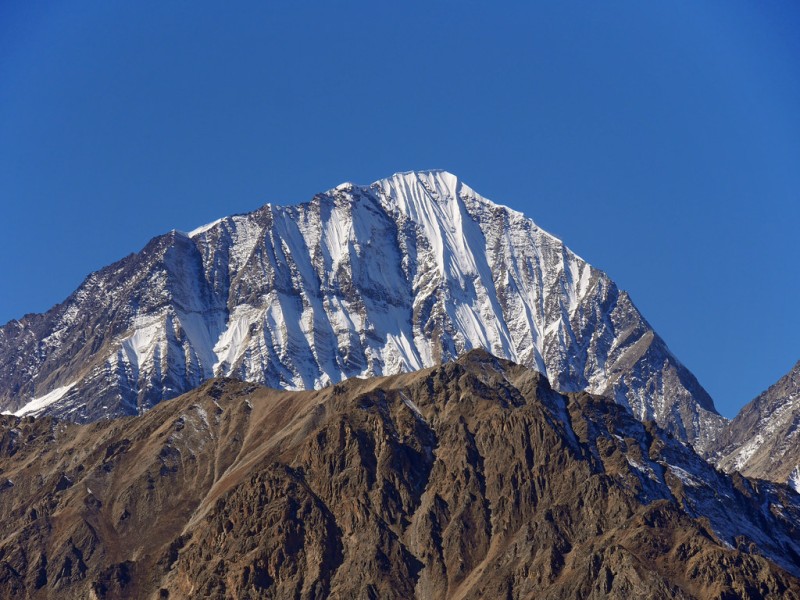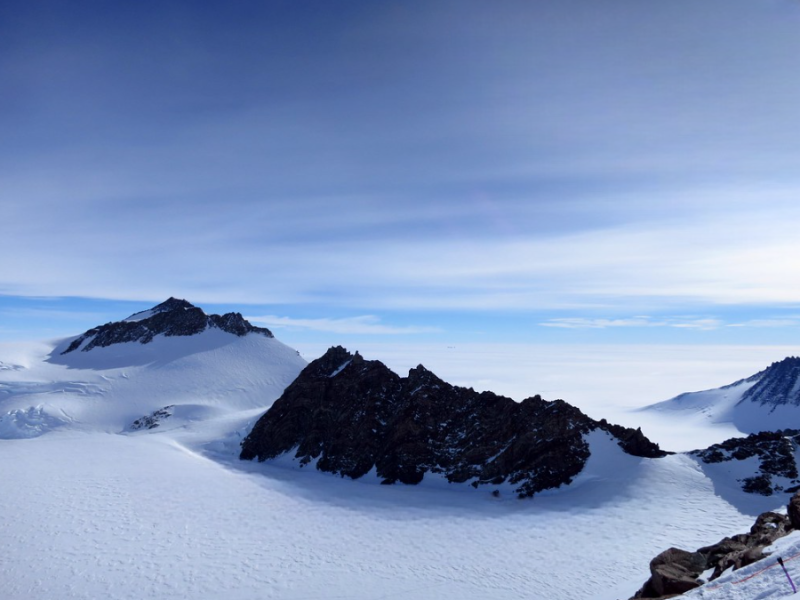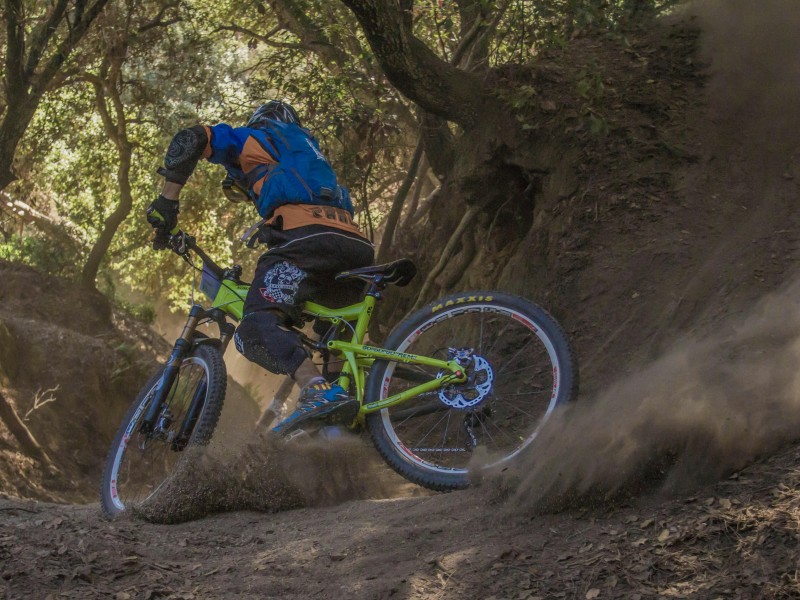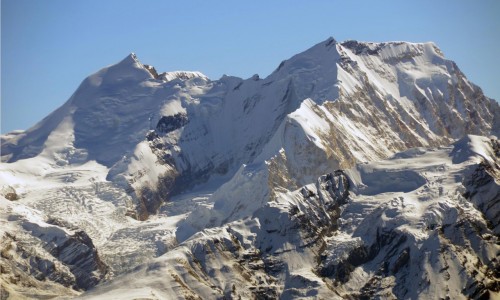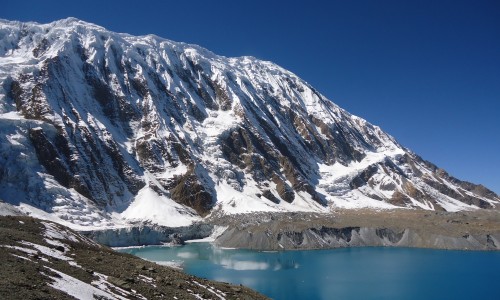Mera Peak climbing (Mera Peak 6,461m), is the most popular and highest trekking peak in Nepal at Khumbu Valley. an exciting and scenically stunning mountain, Situated on the edge of the famous Khumbu Region and dominated by Mt. Everest.
Mount Baruntse is at a height of 7,129m. in between the lap of Everest and Makalu Mountain. Baruntse became famous when a New Zealand expedition including Colin Todd and Geoff...
Mera Peak climbing (Mera Peak 6,461m), is the most popular and highest trekking peak in Nepal at Khumbu Valley. an exciting and scenically stunning mountain, Situated on the edge of the famous Khumbu Region and dominated by Mt. Everest.
Mount Baruntse is at a height of 7,129m. in between the lap of Everest and Makalu Mountain. Baruntse became famous when a New Zealand expedition including Colin Todd and Geoff Harrow made its first ascent on 30 May 1954 via South-East Ridge. Since then many climbers have used this route and succeeded. This mountain has also been becoming coveted day by day like the other Pumori, Ama Dablam as well as Everest too. The South-East Ridge of Baruntse is a little bit difficult because of the straightforward hard ways to climb. There are hard sections of 50.Degrees elevation with a prominent ice cliff to be climbed facing the risk of avalanche. Spring season is the most preferable summit season because of being the season best for climber's safety. But also some climbers have reached its top in the Autumn season as well.
The 33 days long Kathmandu-Mountain-Kathmandu Xtreme Climbers Mera Peak and Baruntse climbing expedition is an adventure and an extraordinarily aesthetic objective for Peak/Mountain climbing as well for the remote and isolated trekking experience in Nepal.
- Country / Location: Nepal / Khumbu Region/Barun
- Starting / Ending: Ramechhap / Lukla
- Transportation: Car, Flight, Tourist bus
- Coordinates / Highest altitude: 27°52'19'' N / 86°58'55'' E / 7129m (23,389ft)
- Difficulty Grade / First Ascent: Mt. Baruntse Peu difficult (PD++) / Colin Todd and Geoff Harrow, May 30, 1954 by New Zealand expedition
- Arrival/Departure From Kathmandu (KTM)
- Accommodation: 3*** to 5***** as per scheduled itinerary
- Meals: B/B plan in Kathmandu & B,L,D in during trekking and climbing
- Culture / Include Activity: Sherpa Buddhism Tibetan / Trekking/Mountaineering/Glacier Safari
- Mode of Adventure: Tea House/Camping
- Himalayan Range / Climbing route: Makalu, Mera, Kanchanjungha / Southeast Ridge
- Duration / Best season: 33 Days / Spring (April, May) and autumn (October, November)
- Group Size: 02-10 People per group
- Trek and climb on the hidden areas of Everest and Khumbu region around pristine Inkhu Valley’
- Amphu Lapcha Pass 5,845m. (one of the most challenging high passes in the Khumbu region. It requires technically enhanced and experienced trekkers to complete the trail. The trek to Amphu Lapcha Pass is through the upper Inkhu valley.
- Trek and Climb of stunning Mera Peak and Mt Baruntse within the high hidden valley of Khumbu and the Everest region
- Exploring high-altitude Sherpa villages enriched with the ancient culture of the Buddhist religion
- Walking into lovely woodland of tall rhododendron-magnolia-firs-pines and juniper trees
- Adventure in complete wilderness away from the main flow of trekkers within high mountains
- Scenic short flight both ways from Kathmandu-Lukla-Kathmandu with awesome mountain panorama
Details of the camps established during ascent:
Base Camp (5,400 meters / 17,716 feet):
- Location: The Base Camp is typically set up at an altitude of around 5,250 meters, near the Barun Glacier.
- Facilities: Equipped with tents for sleeping, a dining tent, a kitchen tent, and communication facilities such as satellite phones or radios.
- Activities: Acclimatization hikes around the base camp area, preparation of climbing equipment, and rest before ascending to higher camps.
Camp 1 (6,135 meters / 20,128 feet):
- Location: Camp I is generally established at around 5,700 meters on a flat section of the glacier.
- Facilities: Tents for sleeping and a small kitchen setup. Facilities are basic due to the altitude.
- Activities: Climbers use Camp I for acclimatization and as a staging point for moving to higher camps. Rest and preparation for the climb to Camp II.
Camp 2 (6,420 meters / 21,060 feet):
- Location: Camp II is typically set up at around 6,400 meters on the Southeast Ridge.
- Facilities: Basic camping setup with tents for sleeping and minimal kitchen facilities. Essential gear and supplies are stored here.
- Activities: Further acclimatization and preparation for the summit push. Climbers ensure all gear is ready and rest to conserve energy for the final ascent.
Camp 3 (optional, around 6,800 meters / 22,310 feet):
- Location: Some expeditions establish this camp if conditions require an additional stop.
- Facilities: Minimal, typically just tents.
- Activities: Rest and preparation for the summit attempt.
Summit Push
- Route: The final ascent to the summit involves navigating steep snow and ice slopes, including a prominent ice wall that can reach 50 degrees in steepness. Fixed ropes are typically used on the steeper sections for safety.
- Timing: Climbers usually start the summit push early in the morning, around midnight or 1 AM, to reach the summit by early morning and descend to lower camps by afternoon.
- Descent: After reaching the summit, climbers descend back to Camp II or Camp I for rest and recovery.
Additional Notes
- Weather: Weather conditions in the Everest region can be highly variable and unpredictable. Expeditions must be flexible with their schedules and prepared for sudden changes in weather.
- Permits: Climbing Mount Baruntse requires permits from the Department of Tourism (DoT) and other relevant authorities. Ensure all necessary permits are secured before the expedition.
- Guides and Support: Hiring experienced guides and porters is highly recommended for navigation, carrying equipment, and ensuring safety during the climb.
- Logistics: Due to the remote location, logistics such as transportation, food supplies, and emergency evacuation plans must be carefully planned and coordinated.
Preparation and Safety
- Training: Climbers should undergo thorough physical training and have experience with high-altitude climbing and technical routes.
- Acclimatization: Proper acclimatization is crucial to avoid altitude sickness. Climbers should follow a carefully planned acclimatization schedule.
- Gear: Essential gear includes high-altitude clothing, climbing equipment (crampons, ice axes, harnesses, ropes), camping gear, and sufficient food and water supplies.
- Health and Safety: Climbers should have a comprehensive medical kit and knowledge of first aid. Awareness of symptoms of altitude sickness and immediate action in case of emergencies are vital.
Expeditions to Mount Baruntse require meticulous preparation, physical fitness, and careful planning to ensure a successful and safe climb.
Mera Peak and Mt. Baruntse Climbing Expedition Strategy:
- Acclimatizing at Mera Peak (6476 m)
- Mera High Camp
- Mera Peak Summit (6476 m)
- Baruntse Base Camp (5400 m)
- Bartunse Base Camp (5350 m)
After ascent over Mera, the team descends down approximately about 500m into the Honku valley and heads towards Baruntse Base camp. Climbers are assured with rich oxygen, warm weather and sunny spells making good conditions for a good night's sleep. The natural environment around is utterly desolate and utterly magnificent in its desolation.
Baruntse BC is at 5350 m, a few kilometers further up the glacier at the entrance to the valley which gives access to East Col. From the camp set up immediately below the pass, it's easy to cross East Col to West col and reach C1 (6,146m) at a large snowy plateau, on the Lower Barun Glacier. This place the expedition team immediately below the South-East Ridge of the mountain and provides a suitable spot for C2 or Advanced Camp 2 (AC 2). This plateau could be reached directly up the Lower Barun Glacier but this approach is not recommended as an icefall at the toe of the glacier has made the route impassable in previous years. So a different strategy where one more camp higher on the mountain, at about 6,500 m is placed, from where the summit is attempted.
The team will practice ascending fixed ropes and rappelling on steep, icy terrain. Hike the glacier just outside of camp and spend a few sessions perfecting skills on overhanging ice. Meanwhile, the Xtreme Climbers Climbing Sherpa team will be fixing ropes high in the mountain for the team. Additionally acclimatization hike to the base of the fixed lines below camp 1. The hike features dirt trails, scrambles over rocks and crossing beautiful glaciers. The day is spent training and preparing for the expedition just below Baruntse Peak and then heading back to Baruntse BC.
Puja Day ( Rituals ) Ceremony: Base Camp - East Col - West Col - Camp 1 (6100m) Approx 8-9 hrs. In the morning before attempting our summit push a Puja ceremony, rituals are performed praying and asking permission to the god mountain for safe passage, success, and safety of the entire expedition team, which is customary before beginning a climb. Many of the western climbers participating take part by placing an object to be used in the climb -Crampons, Boots, and Ice Axe - on an altar that was made from stones and adorned with Tibetan Buddhist prayer flags. The ceremony is concluded with readings and ritual blessings.
Xtreme Climbers climbing Sherpa teams will fix the rope on all the main difficulties of the summit ridge. Sherpas sets up the safest way through the crevasses, overhangs, and icefalls. Sherpa's team carried loads from basecamp at 5400 m to C1 at 6100 m and then returned to BC. The climb mostly consists of a moderate climb with steeper sections at the West Col which is the final ascent before reaching upon Camp 1. Only the last part is more difficult, where the west col consists, a 45-50 degrees 200-metre high ice wall. Beautiful surrounding views of Baruntse, Makalu Ama Dablam, and the Amphu Labtsa which all the climbers will have to cross in a few days time when returning to Lukla.
C1 - C2 (6,400 m) or Advanced camp 2.1 (6,500 m) | Time approx: 3 - 4 hrs: Camp 2 (6,400 m) or advanced Camp 2.1 around 6,500m, in a small col between Baruntse 2 and Baruntse itself. Baruntse 2 is also called Baruntse south-east. The camp lies between the two summits in a saddle-like slope.
Camp 2 - Summit Push - Back to C2 or C1 | Time approx: 09-10 hrs: Technical Challenges at 6900 m ridge. Very sharp ridge at (approximately 6850m). The sharp ridge provides excellent ice climbing over several steep ice walls and extremely exposed cornices. Sherpa team fixing the rope will assess the crevasse opening ridge and there is a consideration of adding a ladder at the top if needed. But normally combining the skills of ice climbing on overhanging ice and through the assistance of fixed rope walking on the narrow steep wall ice wall climbers can overcome the final section of the ridge, then a further One and a half hours more climb to reach the summit. The summit hosts some of the best views of Everest, Lhotse, Makalu, and Cho Oyu, and many other highest snow-capped panoramic views of the Himalayas. After several minutes of summit stand celebration your climbing Sherpa Guide will advise and help you through all to slowly start descending back to C2 or C1 safely to celebrate and recharge some energy in your body.
- Arrival & Departure: Airport - Hotel-Airport transfers (Pick Up and Drop) with private vehicle.
- Hotel Accommodation In Kathmandu: 2-night Hotel (5* Standard) Hotel Accommodation in Kathmandu B/B
- Member transportation:
Overland: 4WD Drive from Kathmandu-Ramechhap-Kathmandu as per itinerary.
By Small Aircraft: Normal Route Air Transportation (Domestic Flight Itinerary): Fly from Ramechhap-Lukla-Ramechhap as per itinerary. - Expedition Stuffs Transportation: Necessary all equipment Transportation for all Members and staff from Kathmandu-Lukla-Kathmandu (by Air) and from Lukla to Base camp (By Porters or Yak/Mules or Donkey depending on group size and expedition weight) – While returning: B.C-Namche (By Yak/Porters depending on group size and expedition weight) and Namche to Lukla (By Porters) and Lukla to Kathmandu (by small aircraft) as per itinerary.
- Climbing and National Park Permit: Lukla VDC entrance permit, NMA Climbing permit of Mera Peak and Mt. Baruntse Climbing permit from Department of Tourism “ DoT”, Makalu and Sagarmatha National Conservation area entry and other required necessary permits.
- Climbing Sherpa Guide: Highly / Technically experienced (Everest and Baruntse Summiteers 1. Member 1. Sherpa) will be provided.
- At Base Camp and C1, C2: Each Member VE-25 North-Face individual Tents, Mattresses, and Pillows per member will be provided at B.C. Camp Above: Two members 1 Tent with High Food will be provided. For HOT Meal proposed EPI GAS and the high expedition Koffel bowl sets will be provided for both members and Sherpa.
- Garbage Management: Garbage Deposit fees.
- Medical & Emergency Heli Insurance: Medical & Emergency rescue Insurance for involved staff during the trek and expedition.
- Member Luggage: Up to 40.Kg per member for personal baggage during the trek carried by the porter. NOTE: baggage is more than 40.Kg p/p will charge extra additional cost at the Airport as well as required of extra porter, Mules, or Yak.
- Porter: 2 members 1 Porters (30.kg max) Lukla-Mountain-Lukla
- XTREME CLIMBERS Equipment: Xtreme Climbers 120.ltr Duffel bags for each expedition member and for trekkers (2 members 1 Bag) Sun Hat and Face Mask to avoid dry dust will be provided.
- Lodging & Fooding: Food 3 meals a day (BLD; including tea and coffee) along with accessible accommodation at the Lodge/Tea house/Camp during the Trek, Basecamp, and Camp above.
- Yak Transportation: B.C-Namche as per the program
- Base Camp Staff: Experienced and well-trained Base Camp Cook & kitchen Helpers as required.
- Base Camp and Camp Above Tent and Equipment: At Base Camp and Camp Above: Each member will have an individual VE-25 TNF, Yak Mountain or Kailas Tent in Base Camp with comfortable foam mattresses Pillow per member, required necessary Dining, Kitchen, Communication, Toilet & Shower Tent will be provided for both Members and Local Nepalese base camp staff, Store tents, Tables & chairs & all necessary cooking gears at BC and Base Camp Above: Two members 1 Tent, High Food, EPI GAS For HOT Meal proposed, Koffel bowl sets will be provided for both members and Sherpa.
- Heater/Solar/Generator/Light: A heater for base camp in each Dining camp, 1 Solar panel or Generator for battery charge, and light at base camp for use will be provided.
- Staff Salary and allowance: All Nepalese staff, Daily wages including Porters and Yak daily wages, salaries, equipment, and food as per the programmed scheduled Itinerary.
- XTREME CLIMBERS Map: Xtreme Climbers Trekking or Expedition Route Map will be provided.
- Medical kit Box: Comprehensive Medical kit for local staff use only.
- Certificate: Mt. Baruntse and Mera Peak climbing certificate issued by MoCTCA and NMA (after climbing Mt. Baruntse and Mera Peak successfully).
- Farewell Dinner: Farewell Dinner in a Tourist standard restaurant with Xtreme Climbers Staff.
Full Board Base Camp Service Cost Includes:
- Arrival & Departure: Airport - Hotel-Airport transfers (Pick Up and Drop) with private vehicle.
- Hotel Accommodation In Kathmandu: 2-night Hotel (5* Standard) Hotel Accommodation in Kathmandu B/B
- Member transportation:
Overland: 4WD Drive from Kathmandu-Ramechhap-Kathmandu as per itinerary.
By Small Aircraft: Normal Route Air Transportation (Domestic Flight Itinerary): Fly from Ramechhap-Lukla-Ramechhap as per itinerary. - Expedition Stuffs Transportation: Necessary all equipment Transportation for all Members and staff from Kathmandu-Lukla-Kathmandu (by Air) and from Lukla to Base camp (By Porters or Yak/Mules or Donkey depending on group size and expedition weight) – While returning: B.C-Namche (By Yak/Porters depending on group size and expedition weight) and Namche to Lukla (By Porters) and Lukla to Kathmandu (by small aircraft) as per itinerary.
- Climbing and National Park Permit: Lukla VDC entrance permit, NMA Climbing permit of Mera Peak and Mt. Baruntse Climbing permit from Department of Tourism “ DoT”, Makalu and Sagarmatha National Conservation area entry and other required necessary permits.
- Garbage Management: Garbage Deposit fees.
- Medical & Emergency Heli Insurance: Medical & Emergency rescue Insurance for involved staff during the trek and expedition.
- Member Luggage: Up to 40.Kg per member for personal baggage during the trek carried by the porter. NOTE: baggage is more than 40.Kg p/p will charge extra additional cost at the Airport as well as required of extra porter, Mules, or Yak.
- Porter: 2 members 1 Porters (30.kg max) Lukla-Mountain-Lukla
- XTREME CLIMBERS Equipment: Xtreme Climbers 120.ltr Duffel bags for each expedition member and for trekkers (2 members 1 Bag) Sun Hat and Face Mask to avoid dry dust will be provided.
- Lodging & Fooding: Food 3 meals a day (BLD; including tea and coffee) along with accessible accommodation at the Lodge/Tea house/Camp during the Trek, Basecamp, and Camp above.
- Yak Transportation: B.C-Namche as per the program
- Base Camp Staff: Experienced and well-trained Base Camp Cook & kitchen Helpers as required.
- Base Camp Tent and Equipment: At Base camp: Each member will have an individual VE-25 TNF, Yak Mountain or Kailas Tent in Base Camp with comfortable foam mattresses Pillow per member, required necessary Dining, Kitchen, Communication, Toilet & Shower Tent will be provided for both Members and Local Nepalese base camp staff, Store tents, Tables & chairs & all necessary cooking gears.
- Heater/Solar/Generator/Light: A heater for base camp in each Dining camp, 1 Solar panel or Generator for battery charge, and light at base camp for use will be provided.
- Staff Salary and allowance: All Nepalese staff, Daily wages including Porters and Yak daily wages, salaries, equipment, and food as per the programmed scheduled Itinerary.
- XTREME CLIMBERS Map: Xtreme Climbers Trekking or Expedition Route Map will be provided.
- Medical kit Box: Comprehensive Medical kit for local staff use only.
- Certificate: Mt. Baruntse and Mera Peak climbing certificate issued by MoCTCA and NMA (after climbing Mt. Baruntse and Mera Peak successfully).
- Farewell Dinner: Farewell Dinner in a Tourist standard restaurant with Xtreme Climbers Staff.
- Airfare: International flight airfare (from and to Kathmandu).
- Nepal entry Visa fee: Nepal Visa fee USD 60 per person for 30 days (to be applied for 60 days (USD 120).
- Sightseeing: Sightseeing around historical monuments and entrance fees.
- Extra night in Kathmandu and Lunch & Dinner: Extra night accommodation and Lunch & dinner during the stay in Kathmandu In case of early arrival or late departure, early return from Trekking / Expedition (due to any reason) than the scheduled itinerary.
- Insurance: Travel and high altitude insurance, accident, medical & emergency evacuation.
- Rescue Evacuation: Medical Insurance and emergency rescue evacuation costs if required. (Rescue, Repatriation, Medication, Medical Tests, and Hospitalization costs.)
- Personal Trekking / Climbing equipment and Personal Expenses: Personal Trekking and Climbing Gear, Internet, battery recharge, Hot shower, Laundry, any Alcoholic beverages & soft drinks (during the trek and in Kathmandu), and Personal Medical Kit bags.
- Filming: Special Filming, Camera, and Drone permit fee.
- Summit Bonus: Summit bonus for climbing Sherpa minimum $.1500 USD per person.
- Tips: Calculate some tips for Base camp staff and Porters.
- Extra: Any other services or activities, which are not mentioned in the itinerary.
- Any other item not listed in the “Cost Includes” section.
Base Camp Service Cost Exclude:
- Airfare: International flight airfare (from and to Kathmandu).
- Nepal entry Visa fee: Nepal Visa fee USD 60 per person for 30 days (to be applied for 60 days (USD 120).
- Lunch & Dinner: Lunch & dinner during the stay in Kathmandu (also in case of early return from Trekking / Expedition than the scheduled itinerary).
- Extra night in Kathmandu or during the trip: Extra night accommodation in Kathmandu or during the trip than the scheduled itinerary. In case of early arrival or late departure, early return from Trekking / Expedition (due to any reason) than the scheduled itinerary.
- Insurance: Travel and high altitude insurance, accident, medical & emergency evacuation.
- Rescue Evacuation: Medical Insurance and emergency rescue evacuation costs if required. (Rescue, Repatriation, Medication, Medical Tests, and Hospitalization costs.)
- Personal Expenses: Telephone, Internet, battery recharge, Hot shower, Laundry, any Alcoholic beverages & soft drinks (during the trek and in Kathmandu but we will serve all kinds of beverages for members in base camp), and also Clothing, Packing Items or Bags, Personal Medical Kit, Personal Trekking /Climbing Gears.
- Filming: Special Filming, Camera, and Drone permit fee.
- Internet Service: Internet services are not included in this cost.
- Summit Bonus: The Summit bonus for climbing Sherpa USD 1500. (If the company offers Full Board Services).
- Customs Clearance: Nepal custom duty for import/export of expedition equipment
- Tips: Calculate some tips for Base camp staff.
- Extra: Any extra expenses arising out of various/unforeseen situations like natural calamities, landslides, political disturbances, strikes, changes in Government regulations, Personal climbing gears or any other services or activities, which are not mentioned in the itinerary or any other item not listed in the “Cost Includes” section.
Related Packages
Copyright ©2025 All rights reserved | Xtreme Climbers Treks and Expedition - Your Adventure Partner in Nepal




















































